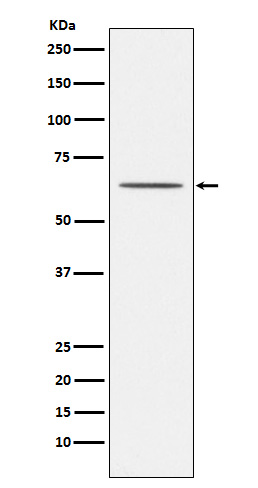Nogo Receptor Antibody
Rabbit mAb
- SPECIFICATION
- CITATIONS
- PROTOCOLS
- BACKGROUND

Application
| WB, IP |
|---|---|
| Primary Accession | Q9BZR6 |
| Clonality | Monoclonal |
| Other Names | NgR; Nogo 66 receptor; Nogo receptor; Nogor; Reticulon 4 receptor; Rtn4r; |
| Isotype | Rabbit IgG |
| Host | Rabbit |
| Calculated MW | 50708 Da |
| Dilution | WB 1:1000~1:5000 IP 1:50 |
|---|---|
| Purification | Affinity-chromatography |
| Immunogen | A synthesized peptide derived from human Nogo Receptor |
| Description | Nogo Receptor mediates axonal growth inhibition and may play a role in regulating axonal regeneration and plasticity in the adult central nervous system. It is also a receptor for Nogo A (RTN4), OMG and MAG. |
| Storage Condition and Buffer | Rabbit IgG in phosphate buffered saline , pH 7.4, 150mM NaCl, 0.02% sodium azide and 50% glycerol. Store at +4°C short term. Store at -20°C long term. Avoid freeze / thaw cycle. |
| Name | RTN4R |
|---|---|
| Synonyms | NOGOR |
| Function | Receptor for RTN4, OMG and MAG (PubMed:12037567, PubMed:12068310, PubMed:12089450, PubMed:12426574, PubMed:12839991, PubMed:16712417, PubMed:18411262, PubMed:19052207). Functions as a receptor for the sialylated gangliosides GT1b and GM1 (PubMed:18411262). Besides, functions as a receptor for chondroitin sulfate proteoglycans (By similarity). Can also bind heparin (By similarity). Intracellular signaling cascades are triggered via the coreceptor NGFR (PubMed:12426574). Signaling mediates activation of Rho and downstream reorganization of the actin cytoskeleton (PubMed:16712417, PubMed:22325200). Mediates axonal growth inhibition (PubMed:12839991, PubMed:19052207, PubMed:28892071). Plays a role in regulating axon regeneration and neuronal plasticity in the adult central nervous system. Plays a role in postnatal brain development. Required for normal axon migration across the brain midline and normal formation of the corpus callosum. Protects motoneurons against apoptosis; protection against apoptosis is probably mediated via interaction with MAG. Acts in conjunction with RTN4 and LINGO1 in regulating neuronal precursor cell motility during cortical development. Like other family members, plays a role in restricting the number dendritic spines and the number of synapses that are formed during brain development (PubMed:22325200). |
| Cellular Location | Cell membrane; Lipid- anchor, GPI-anchor. Membrane raft. Cell projection, dendrite {ECO:0000250|UniProtKB:Q99PI8}. Cell projection, axon {ECO:0000250|UniProtKB:Q99PI8}. Perikaryon {ECO:0000250|UniProtKB:Q99M75}. Note=Detected along dendrites and axons, close to synapses, but clearly excluded from synapses {ECO:0000250|UniProtKB:Q99PI8} |
| Tissue Location | Widespread in the brain but highest levels in the gray matter. Low levels in heart and kidney; not expressed in oligodendrocytes (white matter). |

Thousands of laboratories across the world have published research that depended on the performance of antibodies from Abcepta to advance their research. Check out links to articles that cite our products in major peer-reviewed journals, organized by research category.
info@abcepta.com, and receive a free "I Love Antibodies" mug.
Provided below are standard protocols that you may find useful for product applications.
If you have used an Abcepta product and would like to share how it has performed, please click on the "Submit Review" button and provide the requested information. Our staff will examine and post your review and contact you if needed.
If you have any additional inquiries please email technical services at tech@abcepta.com.













 Foundational characteristics of cancer include proliferation, angiogenesis, migration, evasion of apoptosis, and cellular immortality. Find key markers for these cellular processes and antibodies to detect them.
Foundational characteristics of cancer include proliferation, angiogenesis, migration, evasion of apoptosis, and cellular immortality. Find key markers for these cellular processes and antibodies to detect them. The SUMOplot™ Analysis Program predicts and scores sumoylation sites in your protein. SUMOylation is a post-translational modification involved in various cellular processes, such as nuclear-cytosolic transport, transcriptional regulation, apoptosis, protein stability, response to stress, and progression through the cell cycle.
The SUMOplot™ Analysis Program predicts and scores sumoylation sites in your protein. SUMOylation is a post-translational modification involved in various cellular processes, such as nuclear-cytosolic transport, transcriptional regulation, apoptosis, protein stability, response to stress, and progression through the cell cycle. The Autophagy Receptor Motif Plotter predicts and scores autophagy receptor binding sites in your protein. Identifying proteins connected to this pathway is critical to understanding the role of autophagy in physiological as well as pathological processes such as development, differentiation, neurodegenerative diseases, stress, infection, and cancer.
The Autophagy Receptor Motif Plotter predicts and scores autophagy receptor binding sites in your protein. Identifying proteins connected to this pathway is critical to understanding the role of autophagy in physiological as well as pathological processes such as development, differentiation, neurodegenerative diseases, stress, infection, and cancer.


